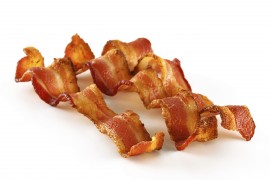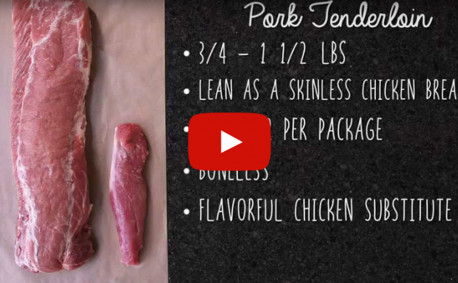What Do All These Labels on My Pork Mean?
You know the scenario. Your phone is ringing. Your kids are hungry. You need to be home in 20 minutes and you've got friends coming over for dinner.
You head to the meat case in a mad rush because you haven't had a chance to eat today, and you see them—labels, claims, stories, nutritional information, pretty pictures, etc. It's a mix of marketing and information only a well-studied scientist can decode.
Grocery shopping is a balancing act. Your job is to buy the "best" for your family and friends while remaining within your household budget. You pick a package and keep moving, not knowing if it's right, but trying your best to feed your family and friends.
To help you choose nutritious food for your family, Kansas Pork Farmers teamed up with Janeal Yancey, author of the blog Mom at the Meat Counter. Janeal, who has a Ph.D. in meat science, makes a few points very clear when it comes to understanding food labels:
- All pork is safe. Ensuring food safety involves everyone in the food chain. Today’s farming operations employ a variety of technologies and techniques to minimize threats to food. All pork is rigorously inspected and follows strict government guidelines to ensure the highest level of safety.
- All pork is grown with pride. Family-owned and family-run Kansas farms are still prominent in today’s farming landscape. Today’s farming combines the best of traditional farming practices with the benefits of modern advancements.
- All pork is nutrient-packed. A 3-ounce portion of pork tenderloin, for example, is an “excellent” source of protein, thiamin, vitamin B6, phosphorus and niacin, and a “good” source of potassium, riboflavin and zinc, yet contributes only 6% of calories to a 2,000-calorie diet. Fresh pork is naturally low in sodium. That’s plenty to consider when it comes to the health benefits of pork.
- All pork is regulated to ensure quality. Added hormones are not allowed in raising hogs. Therefore, the claim “no hormones added” cannot be used on the labels of pork unless it is followed by a statement that says “Federal regulations prohibit the use of hormones.”
Refreshing, isn’t it?
Now that we have that covered, then what is the difference in All Natural and Naturally Raised? Why is Organic so much more expensive? What does No Antibiotics Added mean? Does locally grown specify how “local” a product is?
Below is a quick summary of Janeal's take home messages about other pork labeling, buzzwords and pork claims.
All Natural or Minimally Processed
This means a product containing no artificial ingredient or added color and only minimally processed. Minimal processing means that the product was processed in a manner that does not fundamentally alter the product. The label must include a statement explaining the meaning of the term natural (such as “no artificial ingredients; minimally processed”).
Locally Grown
This term has no USDA guidelines. What defines “local” may vary from one person to another. For some it may represent a drive to a farmer’s market, for others it may be a broader geographic region. The reasons people support locally-grown products (like keeping money in the community, knowing where food comes from, supporting agriculture) may influence their definition.
No Antibiotics Added/Raised without Antibiotics
The phrase “no antibiotics added” may be used on labels for meat or poultry products if sufficient documentation is provided by the producer to the Agency demonstrating that the animals were raised without antibiotics.
Naturally Raised
This term has no USDA standard for pork products, and definitions may vary from one naturally-raised pork product to another. Attributes that may contribute to a hog being “naturally raised” might include being raised without antibiotics, growth promotants or animal by-products in the feed, use of deep straw bedding, being raised outdoors, etc. These will likely be stated on packaging or in marketing materials.
No Nitrates/Nitrates Added
Cured meats by definition must include sodium nitrite. Some uncured products are available that use ingredients like beet or celery juice or natural sea salt to deliver a color and flavor similar to traditional cured meats. When the nitrate in celery, beets and sea salt, and other nitrate-containing vegetables, is exposed to certain types of bacteria in the product, nitrate is converted to nitrite, which results in product characteristics similar to traditionally cured meat products.
Free Range
Also referred to as “pasture raised,” “free roaming,” and “raised outdoors.” The USDA standard to make this claim for pork is that hogs must have had continuous access to pasture for at least 80% of their life.
Certified Organic
The National Organic Program regulates all organic crops, livestock and agricultural products certified to the United States Department of Agriculture (USDA) organic standards. In order to sell, label or represent their products as organic, operations must follow all of the specifications set out by the USDA organic regulations. Pork raised for the certified organic program will be audited by certified organizations, raised on only certified organic land, fed only organic feed and have access to the outdoors. Labeling rules have been established by the USDA for products claiming to be organic and include four categories.
Category 1: 100% Organic
Products produced exclusively using organic methods as defined by the USDA. Can carry the USDA organic certification seal.
Category 2: Organic
Approximately 95% or greater of the ingredients (by weight, excluding water and salt) are organically produced with the remaining five percent of ingredients on the National List of Allowed Synthetic and Prohibited Non-Synthetic Substances. Can carry the USDA organic certification seal.
Category 3: Made with Organic
Approximately 70-95% of the ingredients are organically produced and would be displayed on the principle display panel as “Made with organic [specific ingredient(s)].”
Category 4: Less Than 70% Organic
These products have the option to include “X% organic” on the information panel and only need to list organic ingredients on the ingredient statement.
Government oversight is key to making each one of the above labels accurate.
Food Safety Organizations
Checks and balances help ensure the integrity and security of the food supply at every step in the process, including steps that impact food labels on meat. The U.S. food supply chain has earned a global reputation for the safety of its products, and governmental oversight is part of the reason for this success. Federal, state and local entities contribute to our nation’s food security safety net through regulation or inspection. The following entities have responsibility for various aspects of ensuring food safety.
- U.S. Department of Agriculture (USDA)
- National Animal Identification System (NAIS)
- Food and Drug Administration (FDA)
- Center for Veterinary Medicine (CVM)
- National Antimicrobial Resistance Monitoring System (NARMS)
- Food Animal Residue Avoidance Databank (FARAD)
- American Veterinary Medical Association
- Animal Health Institute
- Centers for Disease Control and Prevention (CDC)
- Food Safety and Inspection Service (FSIS)
- Institute of Food Technologists
- National Institute for Animal Agriculture
- World Health Organization (WHO)
- World Organization for Animal Health
So what does all this mean? Janeal sums up the information simply, “All pork is safe.”
Janeal continues “The best pork label to look for is the price label. Purchase pork that fits into your household budget and feel confident that pork farmers are working hard to provide their communities with good food and choices to fit your lifestyle.”
For a PDF of this information, click here.




